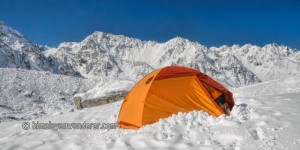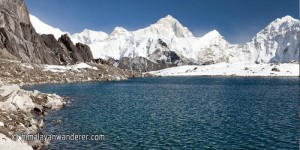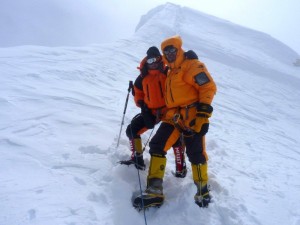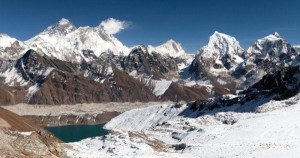The expedition ‘Saipal Himalaya’ start from Kathmandu, the Capital City of Nepal to Bajhang, one of the remotest hilly districts from the Far-West Nepal that lies around 1,000 km away from the Capital City. The expedition gets its name from the Mt. Saipal (7031m), located at Bajhang district, which has no official records till to this date conquered by any humans.
Saipal, besides, as a mountain, is also a center of civilization and religiosity. There are many myths associated with Saipal in the community. One of such Myths is that the mountain is the abode of Hindu Gods and Goddesses. The name Sapial, according to Hindu mythology, is named after Lord Bishnu as Mt. Kailash is named after Lord Shiva. In the Hindu civilization, there are three major Gods-Brahma, Bishnu and Shiva-the Gods of creation, nurturing and destruction. The local people believe that as Mt Kailash is home to Lord Shiva, Mt Saipal, in the same manner is the residence of Lord Bishnu, who rests upon the lap of Sesnaag, a five headed holy Serpent God.
It is a different story in the other side of Bajhang, the southern side of Saipal. According to the cultural king of Bajhang, Narayan Bahadur Singh, the peak of Mt. Saipal is the seat to Lord Bishnu. No human has been successful to reach the top of Mt. Saipal because of the up-front guile of Langa. So, the people in this region offer a special worship to Langa while they visit Saipal for collecting Yarshagumba and other herbs. It is believed that only then Langa will allow them to move ahead in their journey. However, there is a big pasture in the eastern-south side of Saipal which is called Ranikharka. The glacier that runs from Saipal has also made a beautiful lake there. There is also a special cave by the side of the lake. It is claimed that one of the Rimpoche from Humla made a penance at the same cave and reached his perfection. So, the lama community from Humla district visits Ranikharka once a year for the special worship.
Bajhang is one of the least developed districts of Nepal, marked by under-development superstition, unemployment, labor migration, gender discrimination, child marriage and so many other social mal practices. Chaupadi is one of the most debatable traditions in this district because it dehumanizes and discriminates women in the name of tradition and religion. Under the chaupadi tradition, the women are forced to live in a small hut shaped like a cow shed away from home and family members during her menstruation period every month. While staying in the Chaupadi shed many women have already lost their lives because of the snake bites and wild animals attack. In some stances, some of the women were raped and gang raped and killed by the unnamed people taking benefit of the lack of safety and security in such Chaupadi huts.
The expedition itself is an act against the existing forms of discrimination in the community where they have a deeply rooted social belief that women are impure because of the menstruation and hence they are not allowed to climb mountains. The people in this region
believe that their ancestral God ‘Langa’ dwells in the mountains, hence will curse the women if they climb. The disrespect of the God will bring misfortune to them, even leading up to their death or the death of their loved ones.
New Route to Mt. Saipal:
Our first expedition 2018 was failed because of the bad climate and some technical problems. So, our team is planning to use new route in the coming season. Now the expedition team has chosen the route from Bajura district, which is less difficult technically as mentioned by those who have already attempted. In addition, the new route covers most magnificent landscapes of that region which at the same time will also open the door of tourism and prosperity for the region.
The new route selected for the expedition this year has a different peculiarity to other established trekking routes of Eastern Mountains. These are mainly the Khas-Arya populated area. The people here speak different language, which is native to the existing Nepalese language and is called as 'Khas'; however it is different than the present form and difficult to understand even by the persons who speak Nepali in other parts of Nepal. The culture and tradition of this place is very different. One can find the temples of Hindu Gods and Goddess in many parts of Nepal; however the people have a different form of Hindu religion. The people in this route follow 'Masto culture'. There exists no shape of Masto and separate temples for him. He takes his form in Shaman, locally called as 'Dhami'. The saman represents Masto. Though the Shaman is a common person in general, however he takes a form of divine person when he represents Masto. The sight of a white-turbaned Dhami, a shaman, with silver bangles on his arms and gold rings in his ears, will indicate just how far west you are of the modern world. Yet Hinduism and Buddhism blends with animism in local devotions, the most famous object of which was the Khaptad Swami, the renowned ‘eco-saint’ who lived to well over 100 years of age.
Organised tourism has so far been limited to the gentle hills and pastures of the Swami’s home, Khaptad National Park, with its snowy backdrop of peaks. But the pristine forests host abundant wildlife, including leopards, monkeys, bears and rich birdlife. For those with a sense of adventure, there is still much to uncover here – exploration that is as much cultural as it is natural. Just one example is the Chamar’s Dasain, when bulls fuelled with rice-wine and marijuana joust for supremacy – the loser becomes dinner and the winner enjoys a year with the cows!
Trekking in the Far West is authentic as it gets. Trails wind through a land untouched by the hand of time, past ancient orange and lemon groves and flagstoned medieval villages. The history of the Malla Kingdom that reigned here from the 12th to the 14th century is not readily discernible today. But in a land that history has left behind, the visitor is free to experience a taste of what trekking must have been like when Nepal first opened up to the world beyond its borders.
Khaptad National Park is one of the major attractions of this new route. It was established in 1984 on the advice of the region's holy man Khaptad Baba. The renowned Khaptad Baba Ashram, a religious site where Hindu pilgrims come to worship Shiva on the full moon of July–August each year, is located near the park headquarters. A buffer zone of 216 km2 (83 sq mi) was declared in 2006. Khaptad Baba moved to the area in the 1940s to meditate and worship. He spent about 50 years as a hermit and became a renowned spiritual saint. The landscape consists of moorland, steep slopes, and streams. 567 species of flora have been recorded in the protected area. Vegetation types include chir pine-rhododendronforest, oak forest and Himalayan fir-hemlock-oak forest and alder forest in riverine areas. Current checklists include 23 mammals, 287 birds, and 23 amphibians and reptiles. Mammal species symbolic of the park are leopard, Himalayan black bear, wild dog, and musk deer. Bird species symbolic of the park include the impeyan pheasant, peregrine falcon, and white-rumped vulture. Khaptad Baba Ashram lies inside Khaptad National park. Khaptad Baba lived in Triveni located inside the national park and was known as a philosopher, physician, scientist, and astrologer.
Ramaroshan Lake is the other attraction. It is located in Achham district of Nepal at the altitude of 2500m, a place having 18 patch of meadows (locally known as patans. A good view of Budhiganga basin, along with the peaks of Mount Api, and Mount Saipal can be seen from Ramaroshan area. It is known as land of 12 lakes and 18 patch of meadows (grassland) with stiff rocky cliffs. Jigalelake is the largest lake in this area which has the shape of English letter C whereas Taune lake is the smallest one. Among the 18 patans, Kineminepatan is the largest patan, possibly the largest patan in the Achham District through which the Kailash river flows. This place is surrounded by a forest. Terraced hill slopes with lush green landscape surrounding the enchanting Ramaroshan Lake attract everyone. On the route to this destination, travellers come across the forest of Rhododendron. Any species of plants are found in Ramaroshan area. Mostly lakes have been covered by various types of flowers. Many wild animals graze in the grassland of Ramaroshan. It is a habitat of various wild animal i.e. tiger, bear, wild cat, musk deer etc. Ramaroshan is also shelter for various birds like lophophorous, pheasant, cocoo etc. There is natural cliff of stones which is taken as perfect for rock climbing. There is also an opportunity for paragliding from the nearby hills.
13. Badimalika
Badimalika Temple is dedicated to Goddess Bhagwati. It is during the annual festival of Ganga Dashahara held in the temple during full moon in the month of August when pilgrims from Nepal and neighboring countries turn up in thousands to pray and worship. The forest here is a mix of tropical and alpine vegetation ranging from 1000m up to 4000m in elevation. As many as 150 species of wild grassland flowers and berries and over 200 species of herb plans unique to the Himalayas have been recorded in the area. Likewise over 266 species of resident and migratory birds and 20 mammals such as musk deer, black bears, barking deer, Himalayan large cats, langur monkey and many others are also found in the region. To the north, one can see impressive Saipal Himalayan Ranges including the highest Mt. Saipal (7169m). Badimalika Culture Trek is one of the newly opened trekking areas in Nepal, under the initiative of Trekking Agencies’ Association of Nepal (TAAN). The temple and the surrounding areas is one of the least visited trekking areas in Nepal. Nevertheless, it is an important center for religious, historical, cultural and natural attractions.
14. Ranisaina
Historically, the Karnali region of western Nepal flourished on trade between Tibet and the lower hills and plains of Nepal and India. Traders from the Karnali used sheep and goat caravans to bring salt from Tibet down to the plains and trade it for grains and other food, which they then carried back to the mountains where food was scarce. Though the traditional salt trade disappeared after roads came into the region, the ancient trading corridors are still used for seasonal migration of livestock to different grazing areas, and provide excellent opportunities for off-the-beaten-path treks. One of the important livestock corridors is through the KawadiKhola River Valley and up to the grazing area which is called Ranisaina, a beautiful valley at the base of Mount Saipal at 4500 meter. This river valley marks the border between Bajura and southern Humla districts. The area can be approached via Kolti. One can see a beautiful half frozen lake in the base of Mt. Saipal and the snow filled valleys never trodden by the humans except the wild animals and the yaks.

Mount Everest is a peak in the Himalayan mountain range. It is located between Nepal and Tibet,…
Details

Mt Cho Oyu is the sixth highest mountain residing on the border of Nepal and Tibet plains. The first…
Details
Shishapagma, famously known as ‘Gosainthan ‘ which denotes ‘the holy place’, is a mountain located in China elevating 8,027m…
Details
Mount Annapurna Expedition
Mount Annapurna, rising up to 8091 m (26,545 ft) above sea level, is regarded as the…
Details

Mt. Kanchenjunga Expedition
Kangchenjunga, also spelled Kanchenjunga, is the third highest mountain in the world. It rises to…
Details

Makalu is the fifth highest peak in the world elevating up to 8,463m./27,825ft. Its perfect pyramid shape structure…
Details
Lhotse stands at 8,516m, making it the fourth highest mountain in the world. It is…
Details
Pumori peak one of the most popular peaks elevates up to 7161 m which is located in Upper Khumbu…
Details
Mt.Baruntse Expedition (7,162m)
Baruntse is a mountain in the Khumbu region of eastern Nepal, crowned by four…
Details

Ama Dablam
Ama Dablam (6,812 m) is a beautiful mountain located in…
Details


Everest Summit from South Side ( Nepal ) is an opportunity to climb up to the top…
Details